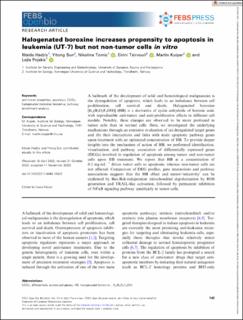| dc.contributor.author | Hadzic, Maida | |
| dc.contributor.author | Sun, Yitong | |
| dc.contributor.author | Tomic, Nikolina | |
| dc.contributor.author | Tsirvouli, Eirini | |
| dc.contributor.author | Kuiper, Martin | |
| dc.contributor.author | Pojskic, Lejla | |
| dc.date.accessioned | 2023-02-13T07:59:52Z | |
| dc.date.available | 2023-02-13T07:59:52Z | |
| dc.date.created | 2023-01-10T12:18:53Z | |
| dc.date.issued | 2022 | |
| dc.identifier.citation | FEBS Open Bio. 2022, 13 (1), 143-153. | en_US |
| dc.identifier.issn | 2211-5463 | |
| dc.identifier.uri | https://hdl.handle.net/11250/3050219 | |
| dc.description.abstract | A hallmark of the development of solid and hematological malignancies is the dysregulation of apoptosis, which leads to an imbalance between cell proliferation, cell survival and death. Halogenated boroxine [K2(B3O3F4OH)] (HB) is a derivative of cyclic anhydride of boronic acid, with reproducible anti-tumor and anti-proliferative effects in different cell models. Notably, these changes are observed to be more profound in tumor cells than in normal cells. Here, we investigated the underlying mechanisms through an extensive evaluation of (a) deregulated target genes and (b) their interactions and links with main apoptotic pathway genes upon treatment with an optimized concentration of HB. To provide deeper insights into the mechanism of action of HB, we performed identification, visualization, and pathway association of differentially expressed genes (DEGs) involved in regulation of apoptosis among tumor and non-tumor cells upon HB treatment. We report that HB at a concentration of 0.2 mg·mL−1 drives tumor cells to apoptosis, whereas non-tumor cells are not affected. Comparison of DEG profiles, gene interactions and pathway associations suggests that the HB effect and tumor-‘selectivity’ can be explained by Bax/Bak-independent mitochondrial depolarization by ROS generation and TRAIL-like activation, followed by permanent inhibition of NFκB signaling pathway specifically in tumor cells. | en_US |
| dc.language.iso | eng | en_US |
| dc.publisher | John Wiley & Sons Ltd on behalf of Federation of European Biochemical Societies. | en_US |
| dc.rights | Navngivelse 4.0 Internasjonal | * |
| dc.rights.uri | http://creativecommons.org/licenses/by/4.0/deed.no | * |
| dc.title | Halogenated boroxine increases propensity to apoptosis in leukemia (UT‐7) but not non‐tumor cells in vitro | en_US |
| dc.title.alternative | Halogenated boroxine increases propensity to apoptosis in leukemia (UT‐7) but not non‐tumor cells in vitro | en_US |
| dc.type | Peer reviewed | en_US |
| dc.type | Journal article | en_US |
| dc.description.version | publishedVersion | en_US |
| dc.source.pagenumber | 143-153 | en_US |
| dc.source.volume | 13 | en_US |
| dc.source.journal | FEBS Open Bio | en_US |
| dc.source.issue | 1 | en_US |
| dc.identifier.doi | 10.1002/2211-5463.13522 | |
| dc.identifier.cristin | 2104011 | |
| cristin.ispublished | true | |
| cristin.fulltext | original | |
| cristin.qualitycode | 1 | |

